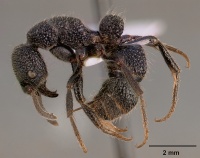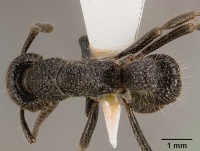Bothroponera pumicosa
| Bothroponera pumicosa | |
|---|---|

| |
| Scientific classification | |
| Kingdom: | Animalia |
| Phylum: | Arthropoda |
| Class: | Insecta |
| Order: | Hymenoptera |
| Family: | Formicidae |
| Subfamily: | Ponerinae |
| Tribe: | Ponerini |
| Genus: | Bothroponera |
| Species group: | pumicosa |
| Species: | B. pumicosa |
| Binomial name | |
| Bothroponera pumicosa (Roger, 1860) | |
Bothroponera are recognized by their behavior in that they build small colonies under stones in moist clay soils. They are mainly specialized to feed on termites (Wheeler, 1922; Wheeler and Wheeler, 1971). Specimens of this species have been found in grassland and karro.
Identification
Joma and Mackay (2015) - A member of the Bothroponera pumicosa species complex. The worker of Bothroponera pumicosa is characterized by a large total length (11- 12 mm). The main distinguishing character of the B. pumicosa worker is the long (up to 0.50 mm or more) golden hairs that are distributed on the entire body including the mandibles, clypeus, and legs. The hairs on the scape are long, at least as long as greatest diameter of the scape. The mandibles are hairy and smooth. The anterior medial margin of the clypeus is convex, “u” shaped, with a raised smooth medial clypeal area on the lower part and is partially carinate on the upper part between the frontal lobes. The lower part of the medial raised area tends to form a groove. The scape does not reach the posterior lateral corner of the head.
The worker of B. pumicosa has a similar “u” shaped anterior margin of the clypeus as those of Bothroponera strigulosa, Bothroponera cariosa, Bothroponera berthoudi, and Bothroponera laevissima. The upper part of the raised area of the clypeus forms a partial carina while it forms a complete longitudinal sharp carina in both B. strigulosa and B. cariosa, but B. berthoudi, and B. laevissima lack the carina. The long hairs (up to 0.50 mm or more) separate B. pumicosa from all of the other members of the B. pumicosa species complex. The hair length of the other B. pumicosa species complex species is less than 0.20 mm for the head; less than 0.25 mm for the pronotum, mesonotum, and propodeum; and less than 0.35 mm for the petiole and postpetiole. The traits of B. pumicosa are very similar to those of B. berthoudi and B. strigulosa, but it can be separated by the longer hairs and the form of the anterior medial border of the clypeus.
Keys including this Species
Distribution
Latitudinal Distribution Pattern
Latitudinal Range: -24.56667° to -34.41667°.
| North Temperate |
North Subtropical |
Tropical | South Subtropical |
South Temperate |
- Source: AntMaps
Distribution based on Regional Taxon Lists
Afrotropical Region: South Africa (type locality).
Distribution based on AntMaps
Distribution based on AntWeb specimens
Check data from AntWeb
Countries Occupied
| Number of countries occupied by this species based on AntWiki Regional Taxon Lists. In general, fewer countries occupied indicates a narrower range, while more countries indicates a more widespread species. |
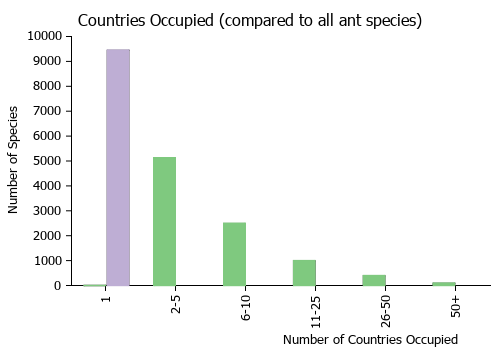
|
Estimated Abundance
| Relative abundance based on number of AntMaps records per species (this species within the purple bar). Fewer records (to the left) indicates a less abundant/encountered species while more records (to the right) indicates more abundant/encountered species. |

|
Biology
Castes
 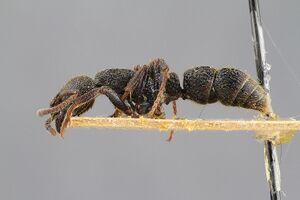 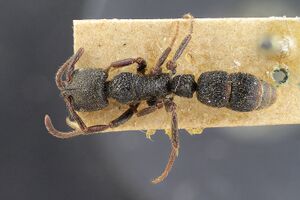 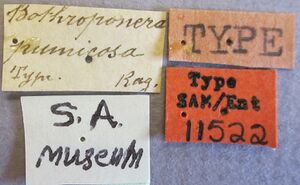
| |
| . | Owned by Museum of Comparative Zoology. |
Male
    
| |
| . | |
Nomenclature
The following information is derived from Barry Bolton's Online Catalogue of the Ants of the World.
- pumicosa. Ponera pumicosa Roger, 1860: 290 (w.) SOUTH AFRICA.
- Type-material: holotype worker.
- Type-locality: South Africa (“Africa im Kaffernlande”): (no further data).
- Type-depository: SAMC.
- [Misspelled as pumicata by Raffray, 1887: 21.]
- Forel, 1901f: 344 (m.); Wheeler, G.C. & Wheeler, J. 1971c: 390 (l.).
- Combination in Pachycondyla (Bothroponera): Emery, 1901a: 45;
- combination in Pachycondyla: Brown, in Bolton, 1995b: 308;
- combination in Bothroponera: Mayr, 1862: 717; Roger, 1863b: 16; Wheeler, W.M. 1922a: 72; Joma & Mackay, 2013: 3; Schmidt, C.A. & Shattuck, 2014: 76.
- Status as species: Mayr, 1862: 717; Roger, 1863b: 16; Mayr, 1863: 397; Dalla Torre, 1893: 36; Forel, 1901f: 344; Stitz, 1910: 130; Forel, 1910f: 4; Emery, 1911d: 76; Santschi, 1914e: 4; Arnold, 1915: 62 (redescription); Wheeler, W.M. 1922a: 72 (in key), 771; Arnold, 1952a: 461 (in key); Bolton, 1995b: 308; Joma & Mackay, 2015: 556 (redescription).
- Distribution: South Africa.
- Current subspecies: nominal plus sculpturata.
Unless otherwise noted the text for the remainder of this section is reported from the publication that includes the original description.
Description
Worker
Joma and Mackay (2015) - (n=5), HL 2.50 - 2.75, HW 2.05 - 2.15, ML 1.30 - 1.40, EW 0.30 - 0.35, EL 0.40, SL 1.75 - 1.80, FL 2.35 - 2.60, WL 3.25 - 3.70, WPL 4.10 - 4.30, PL 1.00, PW 1.20 - 1.25, PH 1.00 - 1.55, CI 82.00 - 78.18, OI 19.51 - 18.60, MandI 51.00 - 52.00, SI 81.39 - 85.36, PetI 120 – 125. Head subquadrate; mandibles with about 8 teeth, covered with hair (0.20 mm in length); maximum clypeal length 1.85 - 2.00 mm; scape not reaching posterior lateral corner of head; maximum frontal lobes width 0.90 - 0.95 mm; frontal furrow well developed; length of malar space from lower edge of eye to base of mandible 0.50 mm; length from upper edge of eye to edge of posterior lobe 1.20 mm; frontal furrow well developed; lower margin of pronotum straight with anteropronotal area forming strongly curved angle, rounded inferior pronotal angle; basalar sclerite oval shaped; mesometapleural suture developed; anterior face of petiole from dorsal view rounded, slightly narrowed, posterior face vertical, slightly concave posteriorly (side view); posterior edge of petiole with slight depression (seen from above); mandibles shiny; antennae, legs, edges of frontal lobes, surface of head densely punctate; pronotum, mesonotum, propodeum, lateropropodeum, and metapleuron densely foveolate; mesopleuron rough with few scattered punctae and foveolae; petiolar and postpetiolar surfaces covered with larger foveolae than those of mesosoma; postpetiolar dorsum partially covered with striae; dorsum of second segment of gaster covered with shallower foveolae than those of petiole and postpetiole, covered with large striae; gastral segments rough, shiny; long golden hairs (up to 0.50 mm or more) distributed on entire body including mandibles, clypeus, legs; hairs on scape long, at least as long as greatest diameter of scape; erect and suberect hairs on body surface as following: head, funiculus, mandibles with long hairs (0.20 mm), hairs on scape about 0.20 mm on far end, about 0.40 mm on near area of scape’s base, hairs on legs about 0.25 - 0.30 mm, on pronotum, mesonotum, propodeum (0.40 - 0.45 mm), on petiole, postpetiole, entire gaster (0.50 - 0.55 mm); head, pronotum, mesonotum, mesopleuron, propodeum, petiole, postpetiole, entire gaster black; femora, mandibles brownish black; tibia, tarsi, antennae, edges of frontal lobes brown.
Type Material
Joma and Mackay (2015) - South Africa: Kaffernlande, Transkei District, 31°30’0’’ S; 29°0’0’’ E, Bothroponera pumicosa type (Roger, 1860) (1 w holotype, #11522.) SAM-ENT (Iziko).
References
- Arnold, G. 1915. A monograph of the Formicidae of South Africa. Part I. Ponerinae, Dorylinae. Ann. S. Afr. Mus. 14: 1-159 (page 62, see also)
- Brown, W. L., Jr. 1995a. [Untitled. Taxonomic changes in Pachycondyla attributed to Brown.] Pp. 302-311 in: Bolton, B. A new general catalogue of the ants of the world. Cambridge, Mass.: Harvard University Press, 504 pp. (page 308, combination in Pachycondyla)
- Emery, C. 1901b. Notes sur les sous-familles des Dorylines et Ponérines (Famille des Formicides). Ann. Soc. Entomol. Belg. 45: 32-54 (page 45, Combination in Pachycondyla (Bothroponera))
- Forel, A. 1901j. Variétés myrmécologiques. Ann. Soc. Entomol. Belg. 45: 334-382 (page 344, male described)
- Joma, A.M.A. & Mackay, W.P. 2015. Revision of the African ants of the Bothroponera pumicosa species complex (Hymenoptera: Formicidae: Ponerinae). Sociobiology 62: 538-563 (doi:10.13102/sociobiology.v62i4.845).
- Joma, A.M.A., Mackay, W.P. 2020. Revision of the African ants of the Bothroponera talpa species complex (Hymenoptera: Formicidae: Ponerinae). Transactions of the American Entomological Society 146: 355-408. (doi:10.3157/061.146.0206).
- Mayr, G. 1862. Myrmecologische Studien. Verh. K-K. Zool.-Bot. Ges. Wien 12: 649-776 (page 717, Combination in Bothroponera)
- Roger, J. 1860. Die Ponera-artigen Ameisen. Berl. Entomol. Z. 4: 278-312 (page 290, worker described)
- Schmidt, C.A. & Shattuck, S.O. 2014. The higher classification of the ant subfamily Ponerinae (Hymenoptera: Formicidae), with a review of ponerine ecology and behavior. Zootaxa 3817, 1–242 (doi:10.11646/zootaxa.3817.1.1).
- Wheeler, G. C.; Wheeler, J. 1971c. The larvae of the ant genus Bothroponera (Hymenoptera: Formicidae). Proc. Entomol. Soc. Wash. 73: 386-394 (page 390, larva described)
- Wheeler, W. M. 1922b. Ants of the American Museum Congo expedition. A contribution to the myrmecology of Africa. II. The ants collected by the American Museum Congo Expedition. Bull. Am. Mus. Nat. Hist. 45: 39-269 (page 72, Combination in Bothroponera)
References based on Global Ant Biodiversity Informatics
- Arnold G. 1915. A monograph of the Formicidae of South Africa. Part I. Ponerinae, Dorylinae. Annals of the South African Museum 14: 1-159.
- Emery C. 1911. Hymenoptera. Fam. Formicidae. Subfam. Ponerinae. Genera Insectorum 118: 1-125.
- Forel A. 1901. Nouvelles espèces de Ponerinae. (Avec un nouveau sous-genre et une espèce nouvelle d'Eciton). Revue Suisse de Zoologie 9: 325-353.
- IZIKO South Africa Museum Collection
- Joma A. M. A., and W. P. Mackay. 2012. A new species of Afrotropical ants in the genus Bothroponera (Hymenoptera: Formicidae: Ponerinae). Psyche 2013: Article ID 917847, (doi:10.1155/2013/917847): 8 pp.
- Joma A. M. A., and W. P. Mackay. 2015. Revision of the african ants of the Bothroponera pumicosa species complex (Hymenoptera: Formicidae: Ponerinae). Sociobiology 62(4): 538-563.
- Santschi F. 1914. Meddelanden från Göteborgs Musei Zoologiska Afdelning. 3. Fourmis du Natal et du Zoulouland récoltées par le Dr. I. Trägårdh. Göteborgs Kungliga Vetenskaps och Vitterhets Samhälles Handlingar. 15: 1-44.
- Wheeler W. M. 1922. Ants of the American Museum Congo expedition. A contribution to the myrmecology of Africa. VIII. A synonymic list of the ants of the Ethiopian region. Bulletin of the American Museum of Natural History 45: 711-1004
